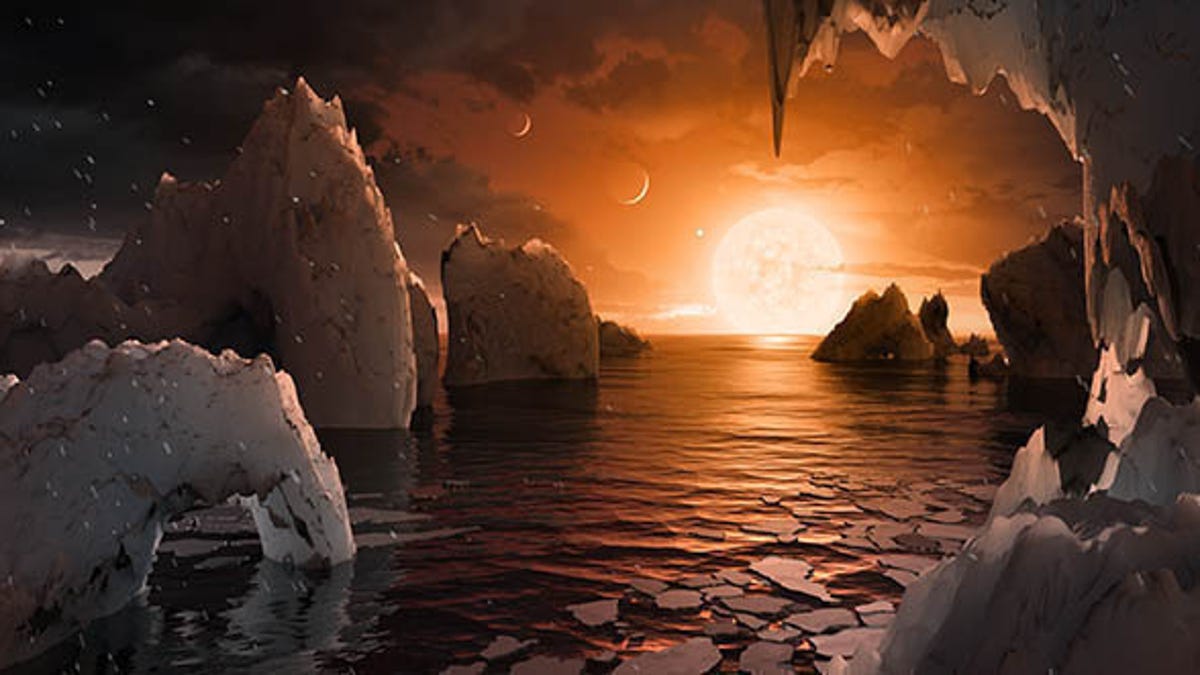The far-fetched but fascinating case for aliens from Trappist-1
Could the system of seven Earth-size planets 40 light-years away host ETs? Some researchers argue they could some day, if they don't already.

If there's anywhere in this galaxy that hosts the kind of busy, space-faring, multi-planetary society seen in Star Wars or Star Trek it's probably the seven Earth-size planets orbiting tightly around the ultracool dwarf star Trappist-1.
While there's no evidence of intelligent life in the system, some of the latest research makes the case that even the outermost Trappist-1 planets could be right for life and, perhaps, even civilizations to evolve.
This week scientists announced new details about the outermost, and therefore probably the coldest Earth-size planet orbiting the star Trappist-1. To the surprise of few, they say Trappist-1h is probably frozen.
Unless, that is, it has a resilient atmosphere that's been around for eons to keep things from freezing up, perhaps even long enough for intelligent life to develop. That's what different research into the Trappist-1 system found.
The pair of studies, both out this month, don't directly contradict each other. Rather, they make different educated guesses because they focus on different aspects of what we can observe about the intriguing system located less than 40 light-years away.
In February, scientists made the big announcement that Trappist-1 was orbited by seven Earth-sized planets, including at least three in the habitable zone. At the time, the astronomers had good data about the size and orbits of six of the seven planets.
This week a team using data from NASA's Kepler Space Telescope was able to confirm more details about the seventh planet, Trappist-1h. They found the planet probably receives about as much energy from its star as the wondrously weird dwarf planet Ceres in the asteroid belt gets from our sun.
If you only consider the new data about the orbit of Trappist-1h, it would seem to be in some pretty chilly territory beyond the habitable zone. If it happens to have water on its surface, it would stand to reason it's probably frozen.
But the universe is not necessarily such a straightforward place.
A different team of scientists looked at the likelihood the Trappist-1 planets have atmospheres that lock in enough heat to keep things from freezing up. They concluded the odds are good that the outermost Trappist-1 planets, Trappist-1g and Trappist-1h, have long-lasting atmospheres and are likely to be habitable.
The research, which has yet to be peer-reviewed, modeled how Trappist-1's stellar wind (the flow of charged particles that stars shoot into space) might erode the atmospheres of the system's seven planets. The same process is believed to have robbed Mars of much of its atmosphere that may have made the ancient red planet a more habitable place.
They found that, solely looking at the likelihood of retaining an atmosphere over the long haul, Trappist-1g and 1h may be the most likely planets in the system to be habitable. Furthermore, if the planets have a truly resilient atmosphere that keeps climatic conditions relatively stable over billions of years, it also ups the chances that not just life, but diverse biology and even intelligent life might exist there now or at some point in the future.
Of course, this is really all just speculation that comes from limited and arguably even cherry-picked datasets. It also makes a number of key assumptions, like the fact that the atmospheres of these planets are not only resilient, but non-poisonous. It's possible Trappist-1h has a thick atmosphere, but it may be filled with sulfuric acid like we see on Venus.
But it's fun to make these educated guesses, especially about Trappist-1. Last month, yet another study concluded that if there's life on one of the planets in the system, it may be able to travel from one world to another via space debris like meteors, seeding each with bacteria or other hardy basic life-forms in the process.
And if germs really are making the trip around the planetary system, it means that with enough time, someone from Trappist-1's version of Starfleet could one day make the same journeys between worlds.
Technically Literate: Original works of short fiction with unique perspectives on tech, exclusively on CNET.
Crowd Control: A crowdsourced science fiction novel written by CNET readers.

